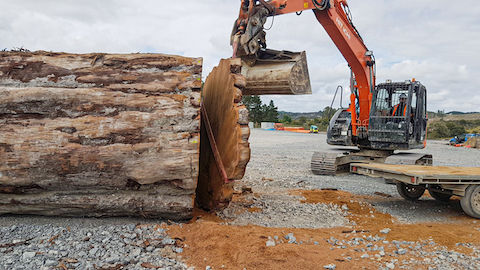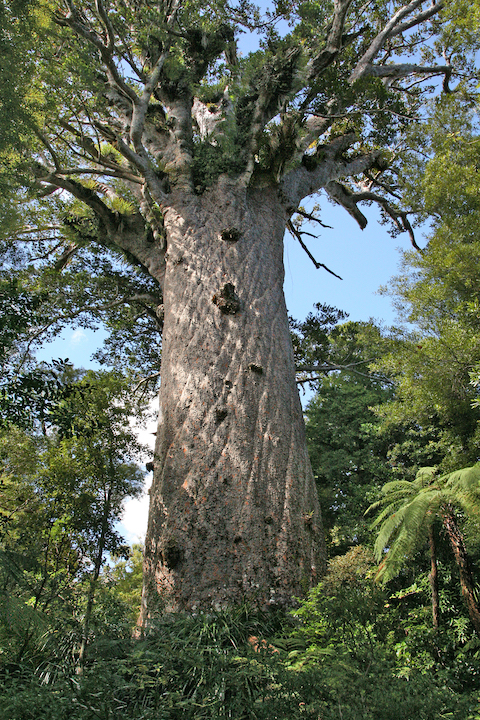
Credit: Jonathan Palmer
In another EarthDate, we talked about Earth’s magnetic polarity reversing.
But sometimes the poles don’t flip, they just go on an excursion—with potentially drastic consequences.
A polar excursion happens when the pole moves more than 45 degrees from Earth’s rotational axis. This happened 12 times in the last million years.
Forty-two thousand years ago, there was a particularly wayward North Pole.
It wandered down to New York, then all the way to Antarctica, before rising back up to its original position.
The excursion took nearly a thousand years. While the pole traveled, Earth’s magnetic intensity fell, to as low as 6 percent—which is what caused the trouble.
You may remember from another EarthDate that Earth’s magnetic field protects us from cosmic rays. With it almost gone, much more radiation could reach Earth.
New data from this period suggests that increased cosmic radiation eroded the ozone layer and altered global wind patterns, causing dramatic climate change.
Ice sheets advanced in the higher latitudes. Drought swept across the middle latitudes. Megafauna went extinct in Australia. Neanderthals went extinct in Europe.
And cave art flourished, perhaps as humans took shelter from weather and harmful solar radiation.
It’s hard to say how much is correlation versus causation. But the poles are always wandering. If a pole goes on an excursion, we may find out for ourselves the effects of a reduced magnetic field.
Background
Synopsis: The magnetic stripes in Earth’s ocean basins depict hundreds of magnetic polarity reversals over the past 250 million years. Geomagnetic excursions happen more frequently and are thought to be failed polarity reversals. Scientists have long speculated about how magnetic events might impact life on Earth’s surface. A detailed timescale from a magnetic excursion 42,000 years ago provides some clues and raises new questions.
- When Earth’s magnetic pole wanders 45° or more from its rotational pole, it is called a geomagnetic excursion.
- Excursions are normally accompanied by a decrease in magnetic field intensity to 10 percent or less of normal strength, often with multiple unruly poles developing.
- The most important aspect of magnetic excursions for life on Earth is the weakening of magnetic field intensity.
- Excursions are generally attributed to reversal of the polarity of Earth’s liquid outer core while the solid inner core retains the original polarity.
- During an excursion, the geomagnetic inertia of the inner core is thought to resist reversing, usually causing the outer core to revert back to the original polarity.
- If the inner core aligns with a reversed outer core, a polarity reversal occurs.
- Polarity episodes, known as chrons, may seem stable but typically show frequent excursions, which are thought to be failed reversal attempts.
- Earth’s most recent chron, the Brunhes Normal Chron, includes today’s magnetic field.
- It completed its 22,000-year reversal about 773,000 years ago, but research demonstrates that it has undergone 6 to 12 excursions since then.
- In 1969, scientists discovered anomalies in basaltic lava flows in central France that are evidence of the 800-year-long Laschamp excursion, the most pronounced excursion of the Brunhes Normal Chron.
- The excursion began about 42,350 years ago and actually achieved a reversal.
- Mineral alignments record longer-term events but do not have the resolution to reveal specific details of the consequences of magnetic field variability.
- Reduced geomagnetic intensity reduces the protective capability of Earth’s magnetosphere, allowing cosmic radiation to slip into the atmosphere, where it produces the cosmogenic isotopes beryllium-10 and carbon-14 through fission reactions.
- Be10 has a half-life of 1.39 million years and is transported via rainwater, making its way into plant material.
- C14 has a half-life of 5,730 years and is incorporated into living things.
- Both are produced when cosmic rays collide with nitrogen and oxygen, causing spallation (breaking off) of some of the elements’ atomic particles.

Credit: W. Bulach, CC BY-SA 4.0, via Wikimedia Commons
- In 2019, while excavating for a new power plant, a huge ancient kauri tree was discovered preserved in a 41,000-year-old New Zealand peat bog.
- The preserved kauri’s rings indicated it had lived for about 1,700 years, spanning the Laschamp excursion. Additional trees were unearthed from the same bog.
- After calibrating the tree rings to ancient cave dripstone records in China, the kauri record provided an account of atmospheric changes that the tree witnessed at 40-year intervals starting about 42,350 years ago.
- It took about 240 years for the polar reversal to occur, with the magnetic field strength dropping to just 6 percent of its present-day strength during the transition while the Magnetic North Pole wandered south to New York, then west to Oregon.
- Then the pole zipped south to Antarctica for just 400 years, developing only about 28 percent of full field intensity.
- Finally, the pole zoomed northward through the Indian Ocean back up to the Arctic, flipping back to today’s “normal” polarity and strength around 41,500 years ago.
- While its protective magnetosphere was diminished, Earth was bombarded by cosmic radiation.
- The sun was also experiencing low magnetic activity at the time, rendering the heliosphere less capable of protecting the solar system from interstellar radiation and increasing the likelihood of solar flare activity.
- Researchers have tied the weakening of Earth’s magnetic field during this event to a cascade of environmental crises—the first time a direct linkage has been reported.
- Previous research suggested that while modern satellites and power grids would certainly suffer, ancient life was probably not impacted much by previous magnetic events.
- Some researchers have noted that large-mammal extinctions tended to occur when the magnetic field was weaker.
- Analysis of the kauri samples confirms a pronounced surge in cosmogenic isotope levels during the transition.
- Additional data reveals modest depletion of the ozone layer, a slight increase in ultraviolet radiation (especially near the equator), and an upward shift in tissue-damaging ionizing radiation.
- Recent models show that high levels of cosmic radiation would have eroded the stratospheric ozone layer, increasing the amount of ultraviolet light reaching Earth’s surface and shifting major weather patterns, such as the Arctic jet stream, dramatically.
- North America cooled as the Laurentide Ice Sheet advanced southward.
- Drought ravaged Australia, causing extinction of the continent’s giant megafauna.
- In Europe, Neanderthals struggled and became extinct.
- Human cave art flourished, possibly indicating a protective retreat into caves to flee skin-damaging radiation.
- Other scientists point to records from the period that do not show evidence of upheaval, especially ice cores from both Greenland and Antarctica, which tend to be very sensitive to temperature changes.
- However, increased Be10 isotopes were identified in ice cores from Greenland.
- Researchers named the weakened magnetic field event at the start of the Laschamp excursion 42,000 years ago the Adams Event in honor of British writer Douglas Adams, author of The Hitchhiker’s Guide to the Galaxy, in which he pronounced that “the answer to the ultimate question of life, the universe and everything is 42.” How did he know?

